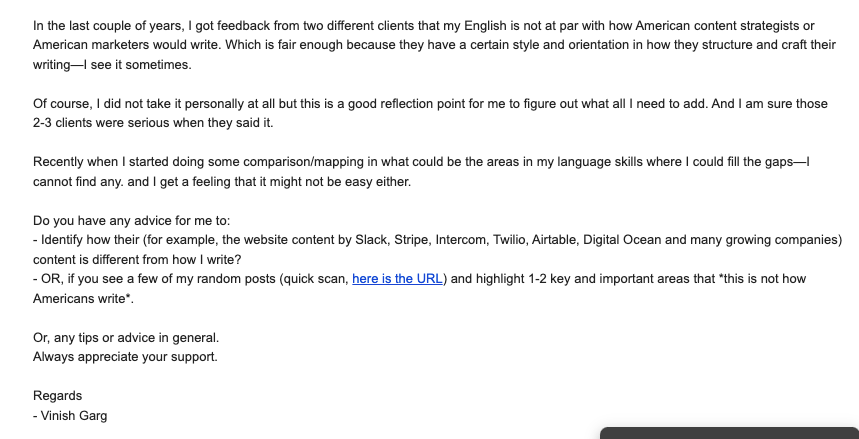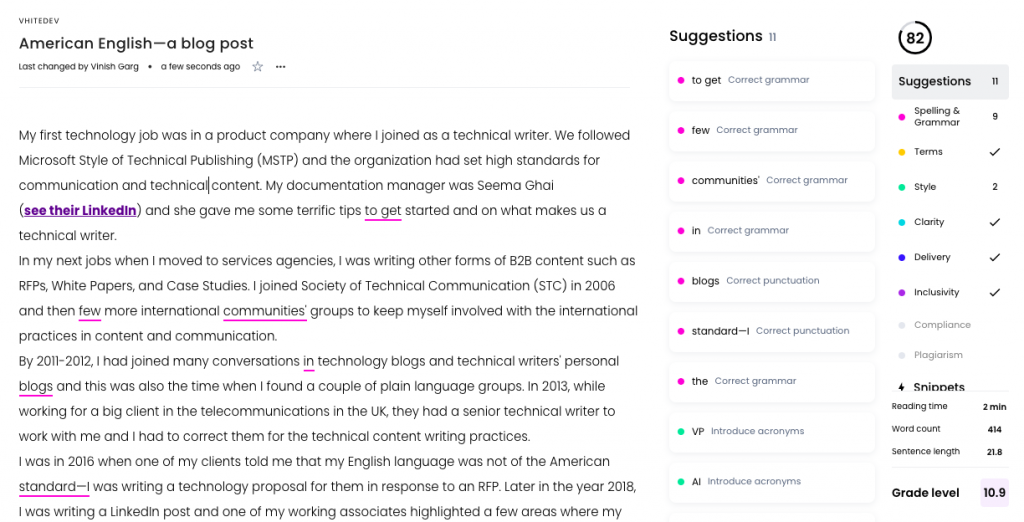My first job in a technology company was in a product company where I worked as a technical writer. We followed Microsoft Style of Technical Publishing (MSTP) and the organization had set high standards for communication and for technical content. My documentation manager was Seema Ghai (see their LinkedIn) and they gave me some terrific tips to get started and on what makes us a technical writer.
I moved to services agencies in my next two jobs where I was writing other forms of B2B content such as RFPs, white papers, and case studies. I joined Society of Technical Communication (STC) in 2006 and a few more international communities and groups to keep myself involved with the international practices in content and communication.
By 2010, I had joined the conversations in technical writing groups and blogs such as by Scott Abel, Mark Baker, Tom Johnson, Larry Kunz, SDL, Marcia Riefer Johnston, Contently, Content Rules, Scriptorium, and few more. In 2012-2013 while working for a big telecommunications client in the UK, I worked with their in-house senior technical writer and I got a few chances to correct them for how they were following the basic technical content writing practices. I felt like a good enough writer.
It was in 2016 when one of my clients told me that my English language was not of the American standards—I was writing a technology proposal for them in response to an RFP. Later in the year 2018, I was writing a LinkedIn post and one of my working associates highlighted a few areas and said that my English was not correct—it was not good enough for Americans.
These made me think whether it is about the habits and culture, or some basic and logical flaws in how I use the language.
Earlier this year, a VP marketing reviewed my content for their website and she found a lot of Indian or non-native English speaker orientation in my work. So I decided to use Writer to see how it corrects me. Writer is an intelligent AI writing platform for the content teams worldwide, I wrote about it recently in a post.
In all three cases, there was no style guide for my reference.
I could see the difference though I was not convinced of all the suggestions that Writer proposed to me. I could see a few areas where I had to use or rewrite certain words to make it more appropriate for the American audience. But I did not want to rely on AI only. Also, I did not have any self-doubts on my English but it was important for me to understand what separates me from them.
The best option for me was to reach out to an expert and see if they had anything to advise me. And they did. I wrote to Jess Sand (see their LinkedIn) and here is a part of my email to Jess.

As often, Jess is kind to reply and to offer their support. She advised me to practice different things and I saw my favorite university professor in her advice.
“One other thing I’ll suggest, which comes from my background in creative writing/poetry, is to adopt a particular practice of studying others’ writing. I haven’t done this in a while, but I used to sometimes transcribe others’ work word-for-word to physically feel what it’s like to write those particular words in that particular order. Then write my own thing but emulating their style. It is really eye-opening, and helps me feel the shape of other styles that I don’t yet know how to get to on my own. It also helps me recognize some of the subtleties in my own style that I might not otherwise be aware of as I’m writing. It’s sort of an exercise in self-awareness through embodying someone else’s voice. Sounds weird, but really enlightening (at least for me).” Jess said.
This is exactly what I was doing in my college before I started my career. I read sports stories in the newspapers and then rewrote these stories in my own words. I never followed the practice for the branded or corporate content though, it could have been a good exercise.
Jess also explained how my writing is different to how Americans write.

If you are in America and you think you are proficient in American English and have some advice for me, you can tweet to me anytime.
Writing this post in Writer
I wrote a part of this post in Writer to see what changes it suggests (Writer is an AI writing platform for teams, see my post on Writer). Here is a screenshot from the same post when I wrote it in Writer.

If Writer can help me write in a language that is more clear, correct, and is accurate, I love this progress in the technology. I am not sure that we have the tools that can guide us for the gaps or flavors or traces whether the content is in Indian English, or American English, or Finnish English, or Australian English—not to address the subtle racism as Jess called it in her reply to my email but to help us focus on the right meaning in the message and this message is subject to the same and common interpretation by Jeniffer Smith in America, by Elijas Korhonen in Finland, by David Taylor in Australia, and by Naman Garg in India.
Our English.
PS: Here is a small video that I found on AEON on the English language—‘Whose language is it anyway?’ The evolution of English, from ‘loaf’ to ‘LOL’
As I said if you are proficient in American English and have some advice for me, tweet to me anytime.
